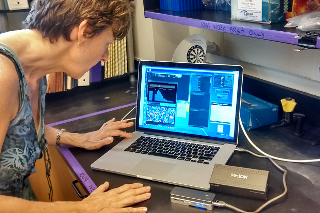Jun 11 2015
In February, when snowfall closed campus and kept her away from the lab, a Virginia Commonwealth University professor who was stuck at home did the kind of work typically reserved for scientists with ample lab space, large machines and a lot of funding.
 Bonnie Brown, Ph.D., works with the MinION device.
Bonnie Brown, Ph.D., works with the MinION device.
Bonnie Brown, Ph.D., associate chair of the Department of Biology in the College of Humanities and Sciences, plugged a small device into her laptop and sequenced the DNA derived from James River water samples.
“From a bucket of water, I can tell what organisms were there, whether it’s frogs, fish or pathogenic microbes,” said Brown, who studies at-risk populations, invasive species and disease-causing organisms in the James River. “And this little device is going to revolutionize sequencing and change the way we collect data.”
Brown and Luiz Shozo Ozaki, Ph.D., associate professor in the Center for the Study of Biological Complexity, have been using a device called MinION as part of an early access program to evaluate the technology. Brown just returned from London, where she was invited by the device’s maker to speak to new users of the technology about her experience with it over the past year.
The device’s small size and relatively low cost could revolutionize when and where scientists perform certain biological studies.
“It’s amazing,” said Ozaki, who plans to use the handheld device to study mosquitoes that transmit malaria and other diseases in the Amazon. “It’s something I can put in my pocket, take into the rainforest and get a genetic sequence right there.”
DNA sequencing is a process scientists use to understand the order of nucleotides in a DNA molecule. By analyzing the order of the four chemical components in a strand of DNA, researchers can paint a picture of an organism’s entire genetic makeup, or genome. They can study individual genes of a single organism or look at all the genes of many organisms in an environmental sample.
Getting the right order is a delicate process. These chemical components, or bases, are paired off 3 billion times in a human genome. In his study of mosquitoes, Ozaki must wade through 278 million base pairs.
Thus, there is a need for machines to piece together sequences based on a DNA sample.
Much of the current technology can “read” strands hundreds of base pairs long. In one run with the MinION, Brown averaged reads of 15,000 base pairs long. Other researchers have recorded reads more than 70,000 pairs long with the device. The larger the strand (or longer the read), the better. If a DNA sequence were a puzzle, long reads mean there are fewer, larger pieces that need to be put in the right spot.
“With short reads, it’s a mess,” Ozaki said. “There are bits and pieces everywhere that need to be put together and you have to guess what goes together and what doesn’t.”
The MinION looks like an old thumb drive and doesn’t require much expertise to use. The device plugs into a laptop or desktop computer’s USB port and connects to the Internet.
The DNA molecules from a prepared sample are dragged through thousands of tiny holes, or nanopores, while being subjected to an electric current. Each of the four bases disrupts the electric current differently while passing through a pore, making it possible to distinguish them and their order.
The MinION is not necessarily the Holy Grail, though it is a disruptive technology that helped stir up the industry.The marketplace is now experiencing an arms race when it comes to sequencing technology, and MinION’s manufacturer, Oxford Nanopore Technologies, is just one of several companies pitching new equipment.
There is Illumina, Pacific Biosciences, Sequenom, Life Technologies and a host of others all fighting for position as sequencing technology becomes more and more accessible. “There’s a lot of competition out there right now, and Oxford [Nanopore Technologies] has some momentum with the MinION,” said Gregory Buck, Ph.D., director of VCU’s Center for the Study of Biological Complexity, which includes VCU’s High Throughput Genomics Core. “But you’re probably going to see some more splashes in the near future with new technologies.”
The MinION still has some accuracy problems. The VCU researchers note that these mostly have to do with distinguishing between true electric signals and noise. The device also could benefit from additional computing power, they said.
“It’s not ready for prime time yet, but it is producing a lot of data,” Buck said. “We want to see it work, and we’re optimistic that it’s going to work. Of course, its main advantage is that you can take it right out into the jungle.” For Brown and Ozaki, the prospect of being able to take a device into the field that can spit out data on location is a dream come true.
“I think this is going to be the future,” Ozaki said. “It’s not only the portability; it’s the cost, too. And it’s not only DNA. You can pass anything — any molecule or protein — through it.”
For now the new technology will aid Brown in her study of the James River, Ozaki in his investigations into mosquito parasites and countless other researchers in their inquiries into human health and other areas. Eventually, though, devices such as MinION will have an even greater reach, Brown said.
“Because it’s so tiny, as the price continues to come down, so many people will be able to use this,” she said. “It could be something used in a high school, out on a boat or even at home.”
“It could be something used in a high school, out on a boat or even at home.”